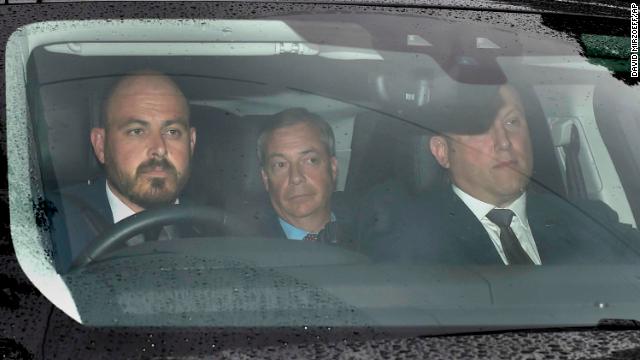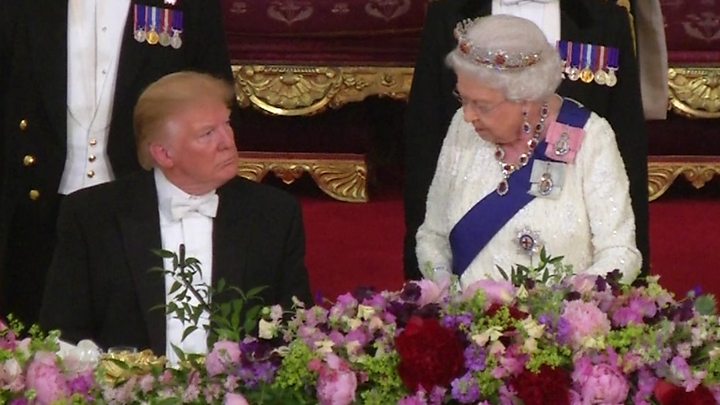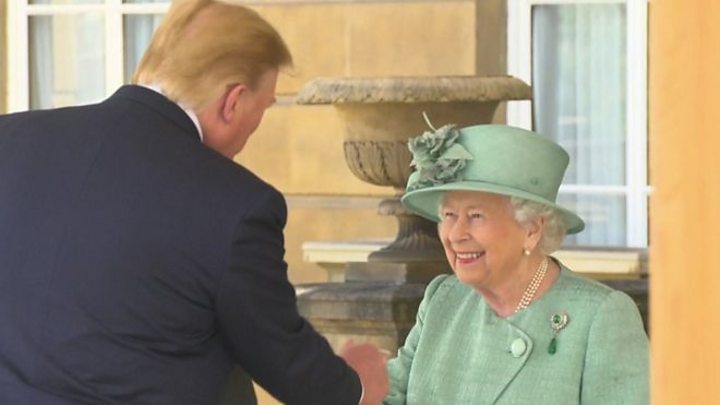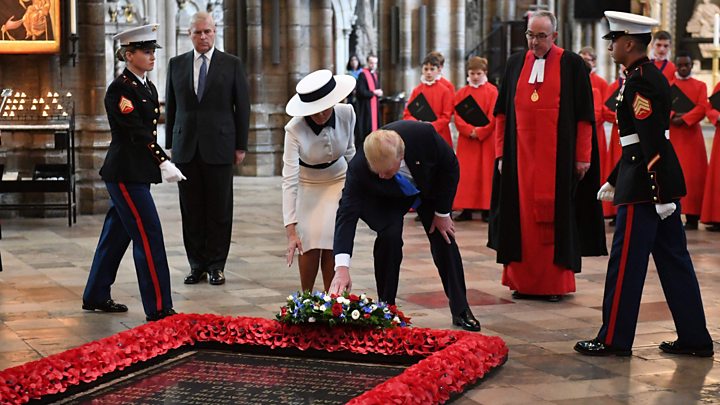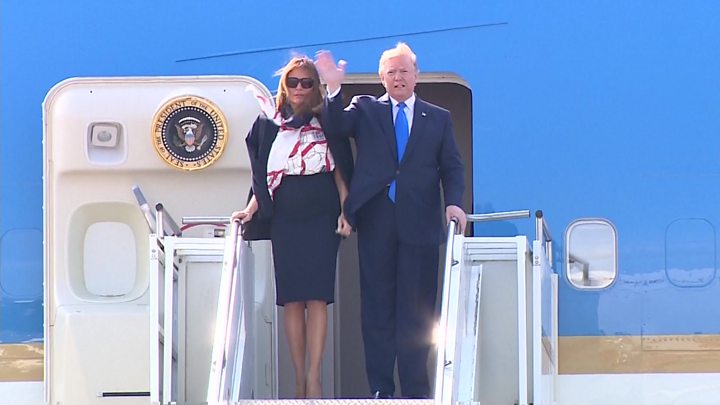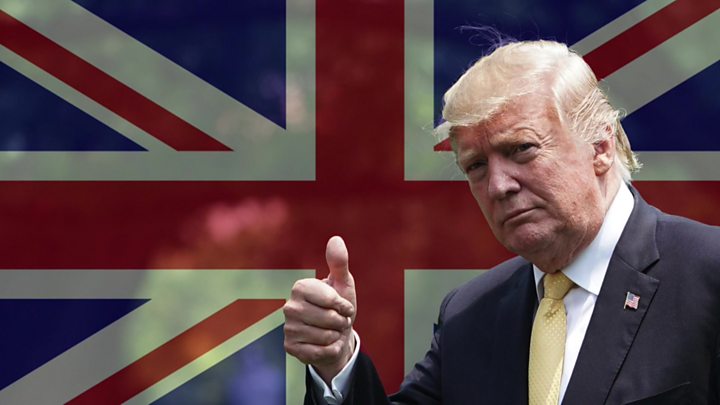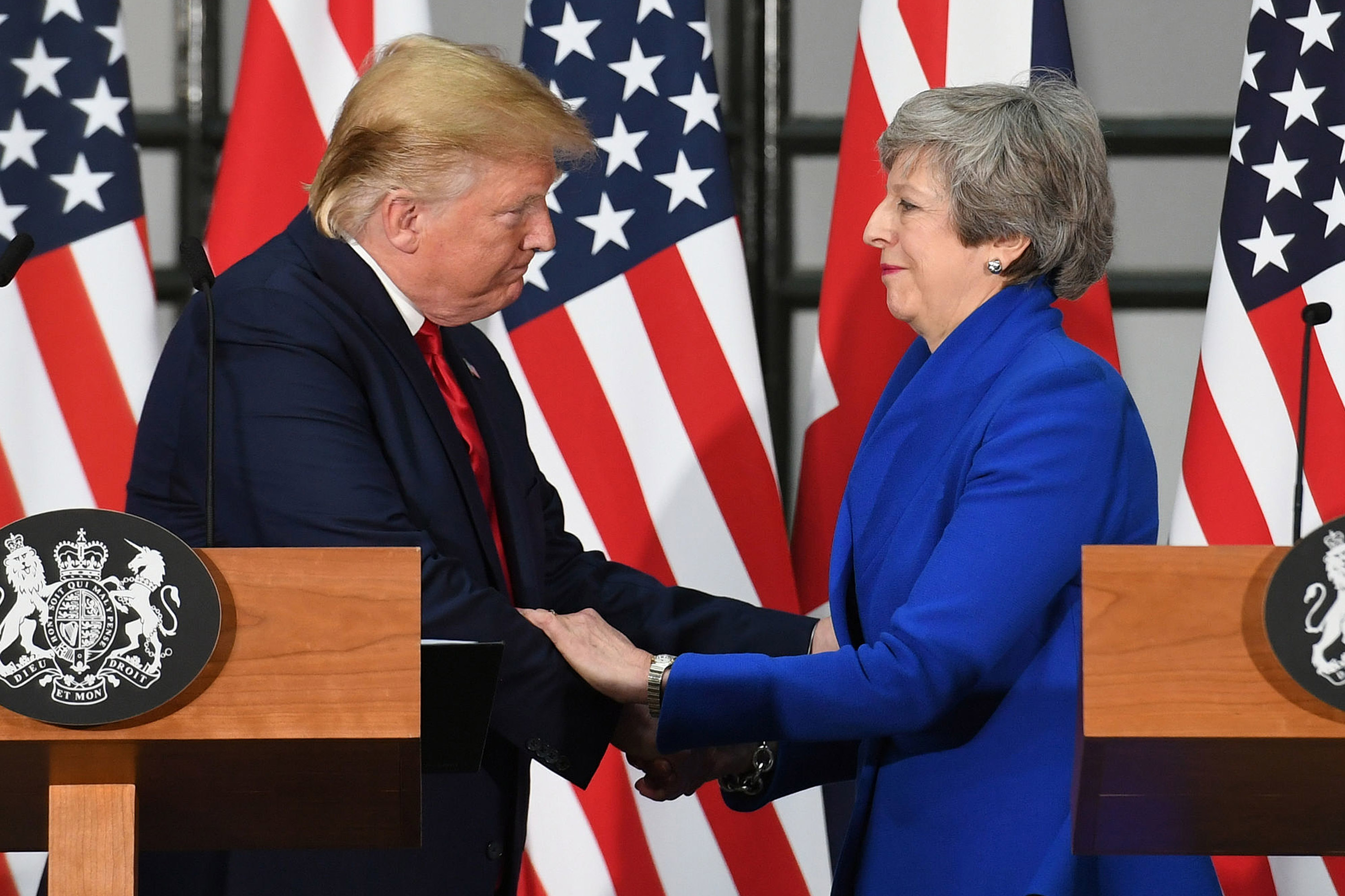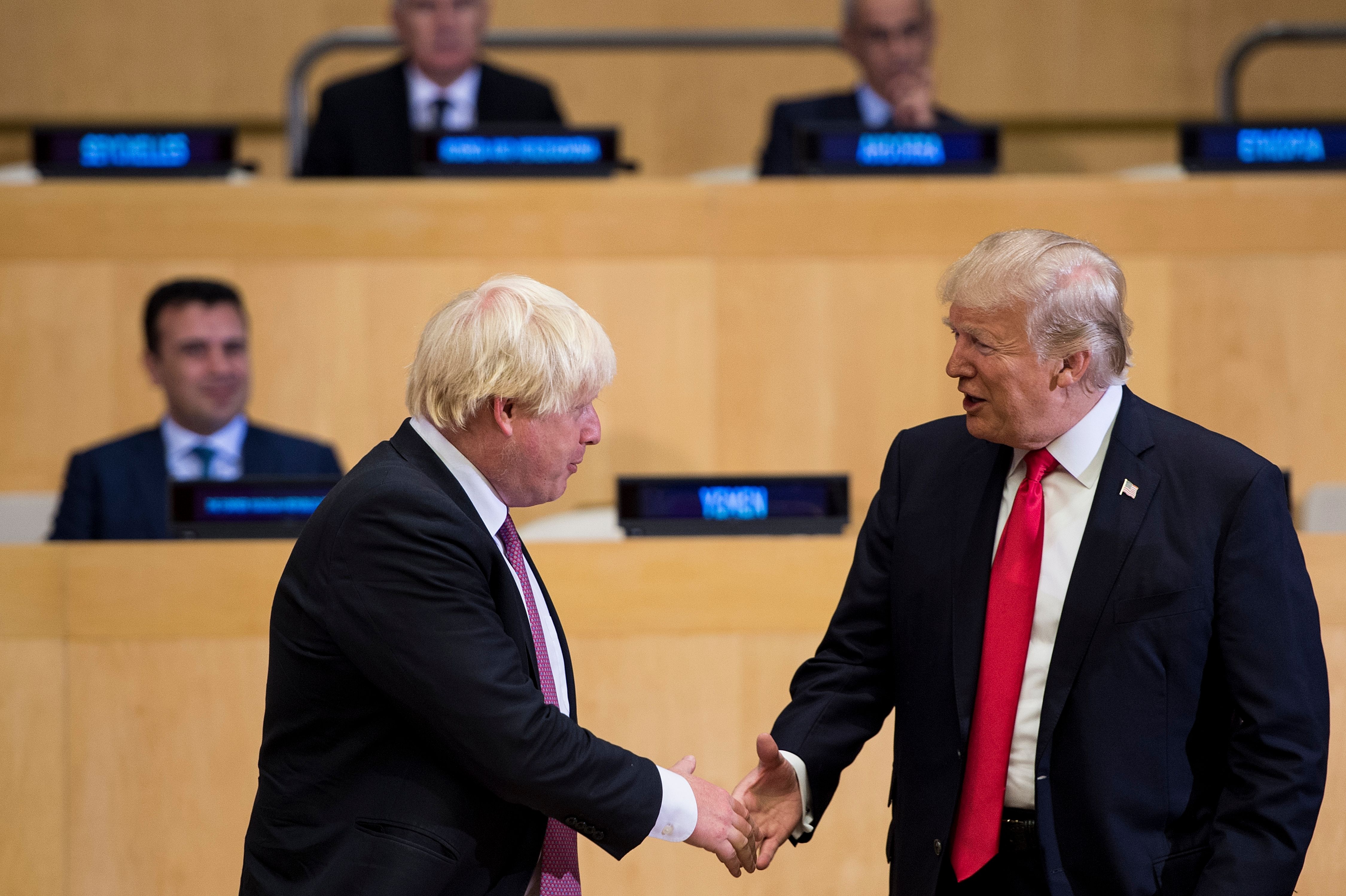President Trump just finished a joint news conference with Prime Minister Theresa May, during an official state visit to Britain that coincides with the 75th anniversary of D-Day. We’ll be updating this story with live coverage.
May said she still thinks it’s in Britain’s best interest to leave the European Union with a withdrawal deal — rather than abruptly crashing out and falling back on World Trade Organization rules. She noted, “I seem to remember the president suggested that I sued the European Union, which we didn’t do. We went into negotiations, and we came out with a good deal.” Trump said, “I would have sued, but that’s okay. I would have sued and settled, maybe, but you never know.” But — in contrast to previous times he’s criticized her handling of Brexit — he granted that May is “probably a better negotiator than I am.”
Asked about the contest underway to replace May as Conservative Party leader and prime minister, Trump acknowledged that he’s not really supposed to weigh in on domestic politics. He then said he knew former foreign secretary Boris Johnson and current foreign secretary Jeremy Hunt and thought both would do a good job. He said he didn’t know Michael Gove, the environment secretary and another top contender.
Trump predicted an agreement over Huawei and dismissed the thought that intelligence sharing might be suspended or curtailed. As far as a new trade deal with Britain, he said “everything will be in the table,” in negotiations, including Britain’s National Health Service. May didn’t take the bait. She said, “the point of making trade deals is both sides negotiate and both sides decide whats in the trade deal.” In response to a question on whether she would take Trump’s hint and stick around to negotiate trade, she said: “Nice try. I am a woman of my word.”
On Brexit, Trump boasted “I predicted it was going to happen.” Despite the trouble Britain has had leaving the European Union, Trump said, “I think it will happen.” He added: “This is a great, great country, and it wants to have its own identity. … I think it deserves a special place.”
Trump was asked a question about the opposition Labour Party leader, who was speaking to protesters outside. Trump didn’t seem to understand and answered with comments London Mayor Sadiq Kahn, with whom he has had an ongoing fued, saying: “I think he’s been a not very good mayor, from what I understand. He’s a negative force, not a positive force.” He responded to a follow-up question on opposition Labour leader Jeremy Corbyn by saying he doesn’t know him but that he, too, is a “negative force.” Trump suggested that Corbyn had sought a meeting, and that he had declined.
Trump said the United States was committed to a “phenomenal trade deal” with post-Brexit Britain, suggesting that trade could increase three-fold. He complimented May as a “tremendous professional and a person who loves your country dearly.”
Prime Minister Theresa May opened the news conference with thanks to “Donald” for cooperation with Britain — for expelling 60 Russian intelligence officers in solidarity after a nerve agent attack on British soil; for carrying out airstrikes in Syria following the use of chemical weapons; and for promoting the idea that NATO members should be sharing the security burden. She signalled Iran and the Paris Climate Agreement as notes of difference. In a line that might refer to Brexit as much as transatlantic relations, she said, “I’ve always believed that cooperation and compromise are the basis” of relationships.
LONDON — With the showy, royal puffery of the queen’s banquet at Buckingham Palace and tea with Prince Charles over, President Trump turned to business Tuesday, and the possibility of a trade deal once Britain finally leaves the European Union.
Trump co-hosted a morning roundtable of American and British corporate executives, alongside British Prime Minister Theresa May, meant to symbolically kick-start discussions for a deal the president is eager to cut.
Trump has talked up a trade pact with a post-Brexit Britain from the start of his presidency, often putting May in a tricky spot, since Britain cannot fully negotiate a deal while still a part of omnibus European Union trade arrangements.
“Great love all around. Also, big Trade Deal is possible once U.K. gets rid of the shackles. Already starting to talk!” Trump tweeted Monday, in the midst of a day of royal treatment that included a lavish state banquet at Buckingham Palace.
In brief remarks at the beginning of the business meeting on Tuesday, Trump said, “I think we will have a very, very substantial trade deal.”
Leaning toward May, Trump said, “I don’t exactly know what your timing is, but stick around. Let’s do this deal.”
May announced her resignation last month — ousted not by the voters or by the opposition, but by her own Conservative Party, for her failure to deliver Brexit on time. She officially steps down as party leader on Friday and will be replaced as prime minister by the end of July.
One of Trump’s allies, former foreign secretary Boris Johnson, is a top contender. Another Trump friend, Nigel Farage, just won big in the European Parliament elections, trouncing May’s Conservatives.
[Trump lashes out at critics during trip to London, but leaves ‘Mr. Brexit’ persona aside]
On Tuesday, May reminded her guests that trade between the two countries was $240 billion last year. “British companies employ a million citizens in the U.S. And every morning, a million people here in the U.K. go to work for American companies,” May said. “And it's a great partnership, but I think it's a partnership that we can take even further.”
Some Britons might have looked askance at Trump’s use of the word “shackles” to describe Britain’s decades-long, willing membership in a trade and political union it was instrumental in shaping. Regardless, in a June 2016 referendum, British voters voted 52 percent to 48 percent to leave the union.
There was a nice moment — out of Trump’s view — when Larry the cat, the official mouser at 10 Downing Street, parked himself underneath the president’s armored limousine nicknamed “the Beast.” As it was raining, the sensible Larry refused to move, NBC reporter Bill Neely noted on Twitter.
As Trump was meeting with May, opposition Labour Party leader Jeremy Corbyn addressed a few thousand demonstrators blocks away from 10 Downing Street.
Corbyn condemned Trump for his tweets calling London mayor Sadiq Khan a “stone cold loser.” Corbyn said he’s proud to have a Muslim as mayor of London.
Corbyn began his address in Parliament Square by praising diversity: “Look at each other. We are young, we are old, we are black, we are white, we are disabled, we are LGBT,” he said.
Corbyn acknowledged that Britain was in the middle of a debate about its role in Europe and the rest of the world. But he said that the debate should not include pushing forward with a ‘no deal Brexit’ and “offering up our precious, wonderful, national health service to private American companies.... We will not stand for that.”
The U.S. ambassador, Woody Johnson, said on Sunday that a future trade deal with America would include “the entire economy” and that medical care should be “on the table.”
May’s health secretary, Matt Hancock, retorted that Britain’s beloved (and oft bemoaned) National Health Service was “not for sale.”
Before bilateral trade negotiators can begin the long slog of crafting a deal, Britain must first exit the European Union — which it has hopelessly struggled to do, as the British government, Parliament and public remain divided over leaving the continental bloc.
Until Britain leaves the European Union — if indeed it ever does — it remains a part of the E.U. and trades with the United States under E.U. rules and regulations.
While policy is mostly taking a back seat to pomp on this trip, the trade deal is Trump’s top priority. His delegation, heavy on family members and staff, also includes Treasury Secretary Steven Mnuchin and other officials focused on a trade package.
The business meeting at St. James’s Palace was attended by the Duke of York, Chancellor Philip Hammond and International Trade Secretary Liam Fox. Also present: Secretary of State Mike Pompeo, Mnuchin and the president's daughter, Ivanka Trump.
As Trump sat with the business community, anti-Trump protesters began to mass for a demonstration against the American president.
It is notable that opposition Labour Party leader Jeremy Corbyn will address the crowds. Corbyn and his party are pushing for a general election that could propel him to the prime minister’s office.
If that happened — and the current polling says it is possible but not assured — the Trump administration would be dealing with a British leader who is openly hostile.
[Baby Trump and the Trump robot headline London protests against U.S. president’s visit]
The anti-Trump rally will mark a return of the Baby Trump blimp, which depicts the president as a whiny diapered baby clutching a cellphone.
Also featured in Trafalgar Square: a 16-foot-tall, talking, animated “robot” of a plastic-cast Trump character, sitting on a golden toilet, his red tie dangling into the bowl, tweeting.
Some demonstrators have dubbed the day’s protest a “Carnival of Resistance.”
Trump will attend a luncheon with May at Downing Street. British officials have suggested that the Iran nuclear deal, global climate change and Chinese telecoms giant Huawei will be on the agenda.
Trump will also be given a tour of the underground bunker where Winston Churchill led the country as prime minister during World War II. The scene has been featured in recent Churchill movies and is a popular tourist site.
Afterward, the two leaders will attend a news conference.
Karla Adam and Toluse Olorunnipa contributed to this report.
Read more
Trump gets a banquet with the queen and the good china on first day of state visit
Trump hobnobs with 171 guests at Buckingham Palace, but some big names skip the banquet
Trump said Queen Elizabeth was a mechanic during WWII. Is that for real?
The long and bitter feud between Trump and London Mayor Sadiq Khan
Why Donald Trump can’t watch Fox News in Britain
As Trump’s state visit looms, Britain seems a reluctant host
Britain is at its most delicate political moment in years. Now here comes Trump.
Today’s coverage from Post correspondents around the world
Like Washington Post World on Facebook and stay updated on foreign news
Let's block ads! (Why?)
https://www.washingtonpost.com/world/europe/trump-says-theresa-may-should-stick-around-for-the-great-us-british-trade-deal-but-shell-be-gone-by-july/2019/06/04/743dfade-8234-11e9-b585-e36b16a531aa_story.html
2019-06-04 13:48:00Z
52780308436784
